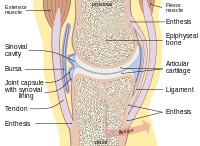
Photo from wikipedia
OBJECTIVE Chronic neurological disorders (CND) generally produce deleterious effects on the musculoskeletal system and can affect physical activity and increase sedentary behavior in children, hindering the execution of training programs… Click to show full abstract
OBJECTIVE Chronic neurological disorders (CND) generally produce deleterious effects on the musculoskeletal system and can affect physical activity and increase sedentary behavior in children, hindering the execution of training programs and the attainment of a correct dose of exercise. The purpose of this systematic review is to analyze the effect of NMES on skeletal muscle and then on biomechanics of movement, functional mobility, strength, spasticity, muscle architecture, and body composition of children and adolescents with CND and chronic diseases. METHODS The search was conducted in April 2020 on PubMed, MEDLINE, Scopus, the Cochrane Library, and Web of Science, without publication period restriction. Publications investigating the effect of NMES on children and adolescents with CND and other chronic diseases were independently selected by 2 researchers. One author independently extracted data from the studies selected, and a second author cross-checked. Eighteen studies with 595 participants aged between 3 and 14 years were included. Quality assessment showed that 50% of the studies presented a low risk of bias. The pooled effect of NMES on gross motor functional measure (GMFM), calculated as a standardized mean difference (SMD) using a random effects model, was 0.41 (95% CI = 0.19 to 0.64). CONCLUSION The use of NMES programs for children diagnosed with cerebral palsy, spinal muscular atrophy, and obstetric injury of the brachial plexus were effective in improving muscle strength, biomechanics of movement, and functional mobility. IMPACT Neuromuscular electrical stimulation (NMES) can be a useful tool to prevent the reduction of mobility that results from CND.
Journal Title: Physical therapy
Year Published: 2021
Link to full text (if available)
Share on Social Media: Sign Up to like & get
recommendations!